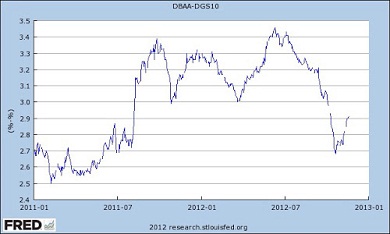My favourite risk indicator in the US, the spread between corporate and sovereign bonds, has jumped again up after the Barack Obama electoral win. By now, everybody knows why: the so-called fiscal cliff that Republicans seem incapable to fix because that would mean to reach an agreement with president Obama.
Already in 2011, tension sparked when a pact upon the debt ceiling–the maximum the US public debt cannot overpass–was delayed to a point in which the government was about to search for creative mechanisms to just avoid default and pay its civil servants. To that, it was added the turbulent cycle of the euro area and its ever increasing volatility.
But after June 2012, thanks to the Federal Reserve printing money and the promise made by the governor of the European Central Bank of buying unlimited volumes of peripheral debt if and when necessary, the risk indicator had relaxed from 3.4 percent to 2.7 percent–much closer to normalcy. The elections and the apparent impossibility of the Republican Party to enter a dialogue with the Democrats has reversed the situation.
The extremists of the Tea Party have ruined the Republican Party and threaten now with bringing to a halt the Congress and the government. These rebels want to cut down taxes but support increasing military spending, that’s their creed, and economic recovery or dealing with the public debt couldn’t matter less to them. The economy of the country, though, was improving. It was. If the risk indicator spikes over the 3 percent mark, all activity will suffer an immediate slowdown. That would make the Obama administration look bad.
In Europe, particularly in Spain, a similar problem would be difficult to replicate, as political parties are much more hermetic. Yet, we must keep an eye open. The US Fiscal Cliff conundrum is a lesson to us all about what not to do.






Be the first to comment on "Extremists and the Fiscal Cliff"